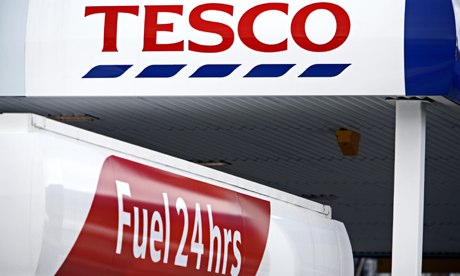
The technology company behind plans by Tesco to use face-scanning software to target adverts at its shoppers has hit back at claims the system will breach customers' privacy.
It emerged on Sunday that Tesco is planning to install the Optimeyes system in all 450 of its petrol stations. The software can analyse images and distinguish men from women and segment them by age, raising privacy fears among some who think it could be used to monitor people's movements.
But Ke Quang, chief operating officer of Quividi, the Paris-based company that developed the software, insisted the system did not retain information about faces it identifies and so cannot track people's movements. "We don't do facial recognition, we do face detection," Quang told the Guardian on Monday. "It's software which works from the video feed coming off the camera. It can detect if it's seeing a face, but it never records the image or biomorphological information or traits. It picks up if it's seeing a man or a woman, the amount of time they pay attention to the screen, and their presence in front of the screen. The key thing though is that it never records or remembers any information. If you go from one camera in one location to another, it can't tell."
The advertising system developed by the British company Amscreen, which is owned by Labour peer Lord Sugar and uses the information about the number, age and gender of the people who are in viewing range of the screen, is able to alter the adverts that it shows depending on who is there. Advertisers can use the information to screen adverts in locations and at times of day that will be most effective at reaching their target audience.
Nick Pickles, of the pressure group Big Brother Watch, said the system did raise privacy concerns: "Scanning customers as they walk through the store without customers ever giving permission for them to be scanned in that way … there's a huge consent issue there."
Quividi's tests have found it to be more than 90% effective at picking men from women. It also aims to segment viewers by age into child, young adult, adult and senior adult. But tests in the US did find that its accuracy dropped substantially – to only 50% – when people, especially women, wore baseball caps. Those obscure parts of the face which the system needs to recognise key elements of the face.
Ke Quang refused to say how the system tells the difference between male and female faces. "That's our secret sauce," he said. But facial recognition systems have long been able to determine gender based on the ratios of the length to the width of the face, placement of eyes, relative height of forehead, and the shape of the chin.
Simon Sugar, the son of Sugar and chief executive of Amscreen, told industry magazine The Grocer that "it's like something out of Minority Report" – the Tom Cruise film in which adverts were tailored to passersby, who were identified by retinal scans – "but this could change the face of British retail and our plans are to expand the screens into as many supermarkets as possible."
The system has already been used in the UK by the charity Plan UK, which in early 2012 used it for an advertising campaign in bus shelters. The screens identified whether the viewer was a man or a woman; men would see information about the Plan website, while women would see a video about the experiences of a number of women from around the world.

